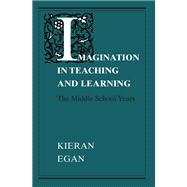
What is included with this book?
| Acknowledgments | |
| Introduction | |
| A Very Short History of the Imagination | |
| Introduction Myth, Memory, and Emotion Ancient and Medieval Imagination Imagination in the Enlightenment | |
| The Romantic Imagination Imagination in the Modern Period: Philosophical | |
| Work Imagination in the Modern Period: Psychological Work Conclusion | |
| Why is Imagination Important to Education? | |
| Introduction Imagination and Conventional Thinking | |
| Imagination in Learning Imagination and Memory Social Virtues | |
| Imagination and Freedom Imagination and Objective Knowledge Visualization, Originality, and Creativity | |
| The Narrative Mind Conclusion | |
| Characteristics of Students' Imaginative Lives, Ages 8-15 Introduction | |
| The Affective Connection Extremes and Limits Romance, Wonder, and Awe Associating With the Heroic Revolt and Idealism Matters of Detail Humanizing Knowledge Conclusion | |
| Imagination and Teaching | |
| Introduction A Planning Framework For Imaginative Teaching and Learning Exploration of the Framework by Means of an Example Less Formal Implementations: Fragmenting the Framework From Characteristics to Principles of Learning Conclusion | |
| Image and Concept Some Further Examples | |
| Introduction Mathematics Science Social Studies Language Arts Conclusion Conclusion | |
| The Role of the Teacher | |
| The Imaginative Curriculum Eliminating Social Studies and Humanities Imagination and Entertainment | |
| Interests and Abilities: Educational Clicheacute;s The Moral Dimension The Logic of the Heart | |
| References | |
| Index | |
| Table of Contents provided by Publisher. All Rights Reserved. |
The New copy of this book will include any supplemental materials advertised. Please check the title of the book to determine if it should include any access cards, study guides, lab manuals, CDs, etc.
The Used, Rental and eBook copies of this book are not guaranteed to include any supplemental materials. Typically, only the book itself is included. This is true even if the title states it includes any access cards, study guides, lab manuals, CDs, etc.